INBOUND 2022: Everything You Missed From Day 2
by Digitopia | Updated Jun 6, 2025
It was another amazing day in the books for INBOUND 2022.
From inspirational speakers like Dr. Jane Goodall to marketing gurus like Niel Patel, Day 2 was packed with incredibly valuable sessions.
The Digitopia team compiled a detailed summary of all the sessions that team members attended so you can benefit from all the incredible insights shared at the event, even if you couldn't attend.
Here is a breakdown of the sessions, click on the links to skip down to the sessions that are most relevant for you:
- Spotlight: Rebuilding Our Connected Future
- RevOps: The Operating System for Scaled Growth
- Getting Smart About Content
- What’s Next: How to Navigate Marketing Around Search and Social Algorithms
- What’s Next: What Ryan Reynolds Taught Us About Advertising
- Category Entry Points In A B2B World: Buying Situations To Brand Sales
Looking for different days? Check out the summary for INBOUND 2022 Day 1 here and INBOUND 2022 Day 3 here.
Spotlight: Rebuilding Our Connected Future
Speakers: Dr. Jane Goodall, Jane Goodall Institute, Founder, UN Messenger of Peace.
Dr. Goodall is a world-renowned ethologist best known for her 60-year study of social and family interactions of wild chimpanzees. She is a UN Messenger of Peace, an honorary member of the World Future Council, author and founder of the Jane Goodall Institute and its youth program, Roots & Shoots.
Katie Burke, Chief People Officer at HubSpot, sat down with Goodall to learn more about how to take action to better the world and what it means to truly have hope.
On Earning Trust
When Goodall first began working with chimpanzees, she had to earn their trust. Burke asked Goodall what it took to do this and how what she learned can be applied to people. Goodall shared that earning the trust of chimpanzees was, unsurprisingly, painstaking. She took specific measures, like wearing the same clothes every day and approaching them gradually, to ensure that they understood that she was harmless. It took four months for her to approach her. Goodall shares that it’s the same with people, “If someone’s shy, don’t push them. Let them come gradually and you’ll gain their trust.”
How Leaders Can Maximize Their Organization’s Impact on the World
Goodall believes there are two versions of her in the world: the Jane that was present in front of the INBOUND audience and ‘icon figure Jane.’ She has to, “work hard to keep up with that Jane.” If someone wants to have an impact, even if it’s not on the level of ‘icon Jane’ she encourages a deep focus on believing in your specific passion. In doing so, you build trust. The alternative, doing job for the sake of doing a job, doesn’t build trust.
On Having a Support System
Goodall had a family, specifically a mother, who deeply believed in her. Even when, as Goodall quipped, she brought earthworms to bed - dirt and all. Her mother recognized that she was curious and encouraged that curiosity. Goodall cited reading books about animals and spending time in nature watching animals as integral in furthering her passion. She recalls a specific life-altering moment that might surprise some - buying the book Tarzan from a second-hand bookshop and absolutely falling in love with, “the Lord of the Jungle.” But, she mused, “he married the wrong Jane.”
Goodall’s infectious enthusiasm for all things nature and animals (and yes, even her love of Tarzan) helped her cement her life goal: To go to Africa to study chimpanzees. She faced considerable obstacles including naysayers and a lack of money for university. But her mother, ever her cheerleader, said, “work hard and you can do it.” To make ends meet, she began a “boring old secretarial course.” Surprisingly, this served her very well. When she eventually made it to Tanganyika (now Tanzania), the famous Dr Leaky had recently lost his secretary. Enter Goodall.
Despite the fact that Goodall did not have a formal education, Leaky believe that she would be better in the field without it (a novel reductionist thinking for an ethologist at the time). She could see the work they were doing with fresh eyes. But Goodall doesn’t eschew the importance of formal education believing that the key to being successful is ultimately passion and the drive to make your passion come to life - “Say, I’ve got to do it. I will find a way to do it and like my mother said, take every opportunity.”
On Sustainability and Climate Change
Burke highlighted that much of the sustainability movement focuses on action spurred by shame and guilt. She asked Goodall how this can be reframed to consider how people can do small things and have a big impact on supporting the environment long term.
Goodall referenced dog training when considering this question (stay with us, here). “The question about guilt made me think ‘ah!’ this is about dog training. Guilt isn’t the best way to get the best performance from a dog. It’s the same with people. Instead, talk about how every single day we can make an impact and we get to choose what impact we can make.”
On Hope: Hope is About Action
“When you look at what’s happening in the world, the divisiveness, the discrimination, the gap between rich and poor - it’s an unfair world, it’s not surprising that people get angry,” says Goodall. “The reason I have hope is, first of all, because we have a program for young people, Roots and Shoots. It began to give young people hope.” Goodall believes that there is still, absolutely, a window of time to fix the problems humans have caused. But, she emphasizes, “Hope is about action - not just wishful thinking.” She encourages people to empower younger generations to take action - let them choose their passion projects (to help people, to help animals, etc).
Goodall also highlights that the difference between us and, say, chimpanzees, “is our intellect -not intelligence because intelligent people don’t destroy their homes.” But we can use this intellect to build upon advancements like creating tech for renewable energy and understanding that regenerative farming and permaculture are better for the environment than factory farming. “I use every moment I can to tell people that the factory farms are not only unethical but produces methane gas, uses up water, and more.” She believes that people are beginning to understand the impact of factory farming - she sees more vegetarians and more vegans. And she believes in the resilience of nature and the will of the human spirit, “We can destroy a place and make it ugly, but if we give it a chance, nature can come back,” she shares, “And there’s the indomitable human spirit that won’t give up and even if [somenone doesn’t] succeed in their [mission during their] lifetime, they inspire people who will carry on their passion.”
RevOps: The Operating System for Scaled Growth
Speakers: Sid Kumar, HubSpot SVP, RevOps. Alison Elworthy, HubSpot EVP, Revenue Operations.
HubSpot defines RevOps as the operating system to power a delightful customer experience. Often times with customer sucess, there’s no process to support a smooth end-to-end journey. HubSpot was getting frequent feedback from customers about friction and inefficiencies in the process. It was hard to become more efficient and effective with the handoff between departments. The answer is RevOps.
The Flywheel is all about delighting customers and driving business growth. RevOps is about reducing friction in the flywheel and providing fuel.
How did we create RevOps at HubSpot?
There was a need for operations within each of our teams. Over time, we noticed that we were creating silos. We were using different systems, different KPIs, strategies, and so on. The answer was shifting from a vertical strategy to a horizontal one. You want a single foundation. You want horizontal alignment. This is how you solve for the customer and create a unified experience across departments.
This is what our vertical strategy looked like:
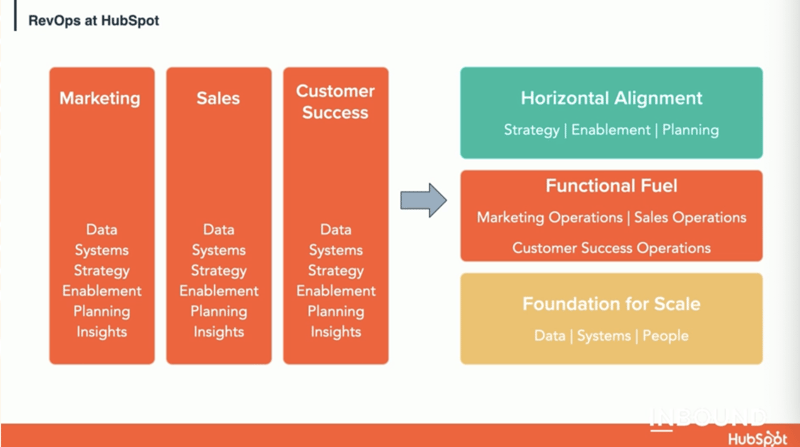
And this is what our horizontal strategy looked like:
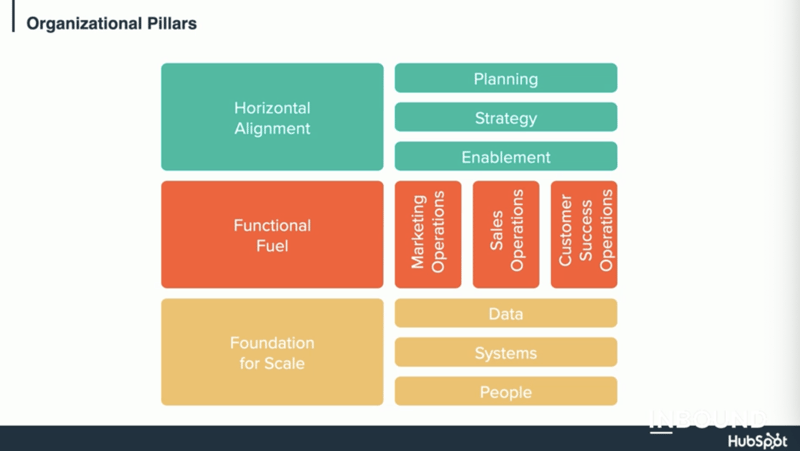
What is the foundation for scale?
The image below does a great job. We want to break linear growth. As you continue to grow and scale, it’s important to gain leverage and bend the curve.
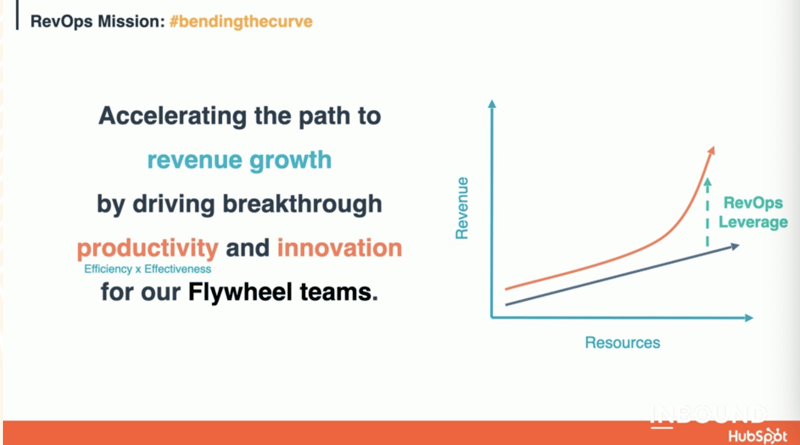
How do we make it seamless for our go-to-market organization for a seamless experience that's enriching and feels like an end-to-end experience and has fewer handoffs?
People. Mechanisms. Insights. Automation.
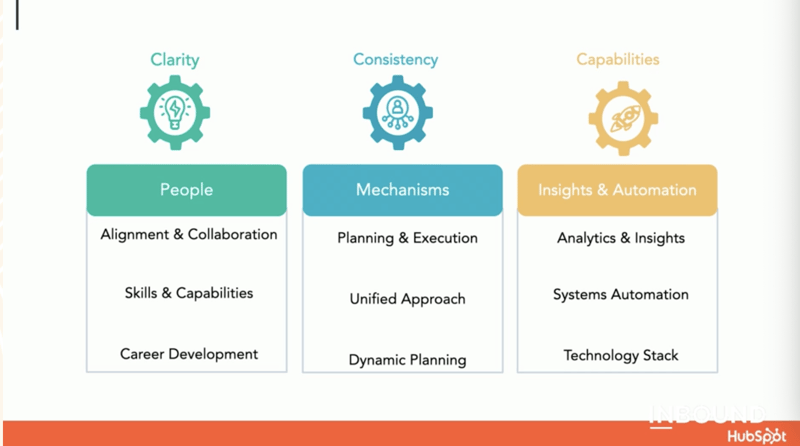
Here's the breakdown of 10 important factors to consider:
1. People
We were really intentional about hiring and who we bring on for RevOps. RevOps is about becoming a strategic partner for the business and having a seat at the table with the C-suite. It’s something we spend a lot of time thinking about.
Systems and data. Oil in our systems. We need to build foundational capabilities as the bedrock. What data do we need for analytics of end-to-end experience? How can we continue to improve? We run on HubSpot, so we use that platform for our foundation of systems. But also, what does our tech stack look like and how can it scale for our teams?
Think about RevOps members as COOs of the organization. They help avoid potholes and capitalize on opportunities that may arise. These are capabilities that cut across all of our pillars and is why we decided to elevate RevOps to horizontal across departments.
2. Strategy
Plan 3-5 years out. Where do we want to be? What are the investments? What are the bets we will need to make? Long-range planning is crucial to success.
3. Enablement
Enablement is so important from a productivity standpoint. How do we constantly keep our people informed about what’s going on and how we can help our customers and partners be successful?
Scale by definition requires repeatable motions. Capabilities in addition to people and processes are what we are investing in to drive non-linear growth. People are the epicenter of our organization. Alignment and collaboration the process of being aligned across every point of the journey is so important to have a frictionless experience. RevOps can drive a critical role in the connective tissue and thread the teams along each part of the customer journey.
4. Skills and Capabilities
RevOps is in a bit of an evolution turning into a revolution right now. What type of skills do we need? How do we balance a traditional ops background and create a melting pot of skills and capabilities that will help us see around corners?
5. Development and Progression
We’re hiring right out of college all the way to people who have been in the industry for a long time. We want diversity and varying viewpoints. We are very clear about what the competencies we need are at each of the different horizontal pillars and what support we need to bring in terms of training and mentorship to help them grow their careers.
6. Mechanisms
If we talk about mechanisms, that's how we drive excellence. We needed a more integrated way of planning. We started working backward from the customer and working backward of what we want to achieve in the next fiscal year. We asked ourselves, "what are the tradeoffs, where are we willing to compramise, and what makes the most sense to customer experience?" Risk and opportunity assessments are critical to planning. If you put the effort here, you can have the best odds at coming into the next fiscal year and achieving success depending on how you define success.
7. Functional Depth and Horizontal Growth
Let’s not lose sight of the fact we are solving for our customers and partners. We can then see how that translates into our structures. It’s important to see what are those horizontals in your organization.
8. Dynamic Planning
Think about how to maintain agility. We are in a dynamic market right now, and this is creating an environment where you may need to make changes part way through the year without disruption. Dynamic planning allows you to pivot as needed and capitalize on new opportunities that arise or avoid pitfalls you didn’t see when you planned originally.
9. Insights and Automation
How do we drive velocity and business agility? How do we drive rep efficiency? It starts with a common data architecture on top of which we are thinking about leading indicators across the journey, and the ability to pivot based on the information.
Systems automation is the constant balance of "when do we need people involved with a customer" or "where can we have an automated approach?" It's important to find how to streamline and keep reps in front of customers where needed while freeing up their plates where tasks can be automated. What are the tools needed for this?
10. Tech Stack
This is one that we are activley thinking about. We run HubSpot on HubSpot. This gives us our full intent across the flywheel. But we are constantly thinking about what are the additional tools we need to support our goals? We have over 1100 partners in our ecosystem and we think "what do we need for our end-to-end engagement model and a unified experience for sales reps and customer success reps?"
At HuBSpot, we have a RevOps community and we encourage you to connect with them to grow your journey.
Getting Smart About Content
Speakers: Mike K. Tatum, Athletic Greens Director, Lifecycle Marketing
What is Smart Content?
A lot of HubSpot users don’t understand smart content and how to leverage it. Smart content gives you the ability to dynamically customize any modules (text, images, videos, etc.) in HubSpot, including custom modules. You can make it personalized to previous conversations with that individual.
Smart content is different from personalization tokens. For example, personalization tokens allow you to add things like first name and company name to emails. It’s great to do this, but this doesn’t get people excited about personalization. This has been going on since the beginning of CRMs and is usually as far as people get. We want to bring you into 2022.
You can give a different variation based off of who you are talking to and provide recommendations based on products they are interested in.
Laying the Personalization Foundation
What can you do to get the most out of smart content? I want to spark the creative juices for how you can leverage this for emails, landing pages, etc.
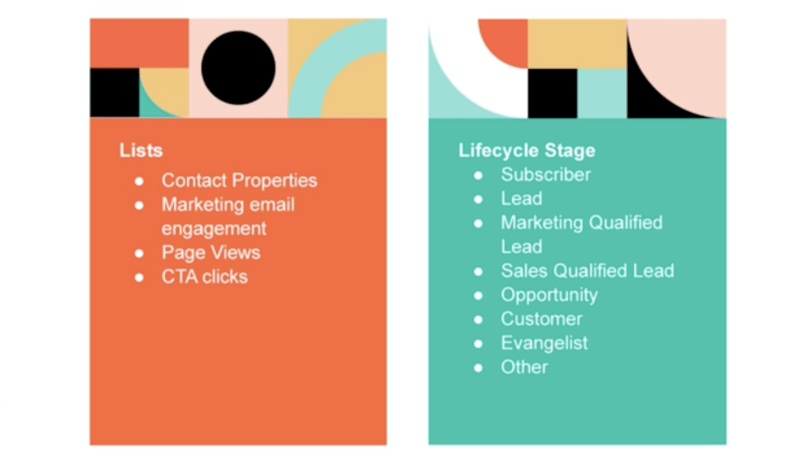
Smart content can fire off of two different things:
1. Lists
The possibilities here are endless in how you target and segment. You can change based on specific page visits, custom properties, email engagement, CTA clicks, and more.
2. Lifecycle stages
You can show a CTA based off of a certain lifecycle stage and customize it for that point in their journey. Someone who is a lead may need different messaging than someone further along in the funnel, like SQL or Customer.
Smart content improves your workflows too. Instead of creating a bunch of different emails, you can consolidate everything into one email.
Where does Smart content live in HubSpot?
In the email builder, if you hover over any module you can find Smart Content under the dropdown that says add "smart rule."
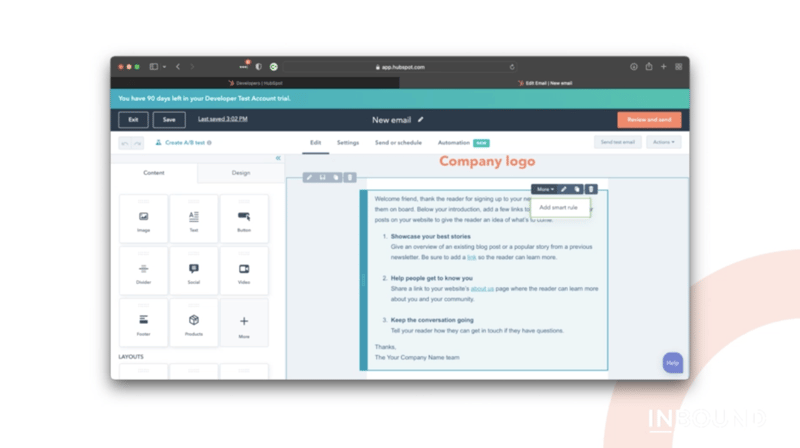
You can also use this in CMS Hub and in Landing pages, but we’ll focus on email today for simplicity.
You’ll see a box pop up that asks what you want to base it off of:
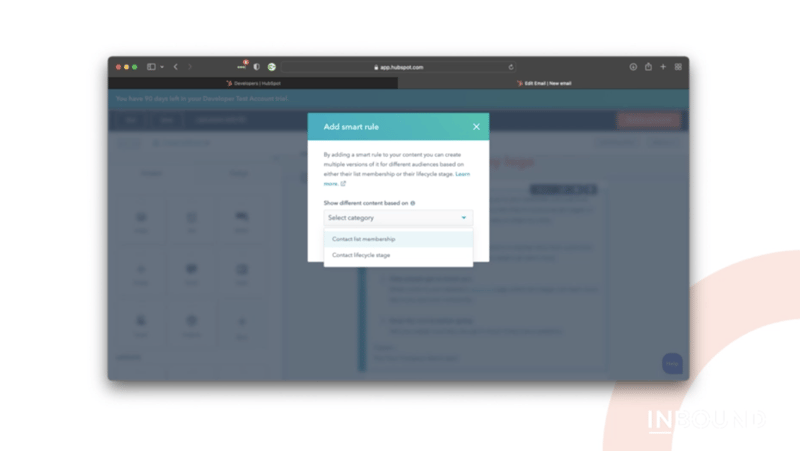
For this example, I’ll click on lifecycle stage. It will ask you which stages you want to personalize for. You can select any of these. We’ll select customer and then next, it will bring you to a "manage smart rules" section and you can add as many rules as you want. HubSpot will go through these rules in order until they get to a “yes”. If none are met, they will receive a default version.
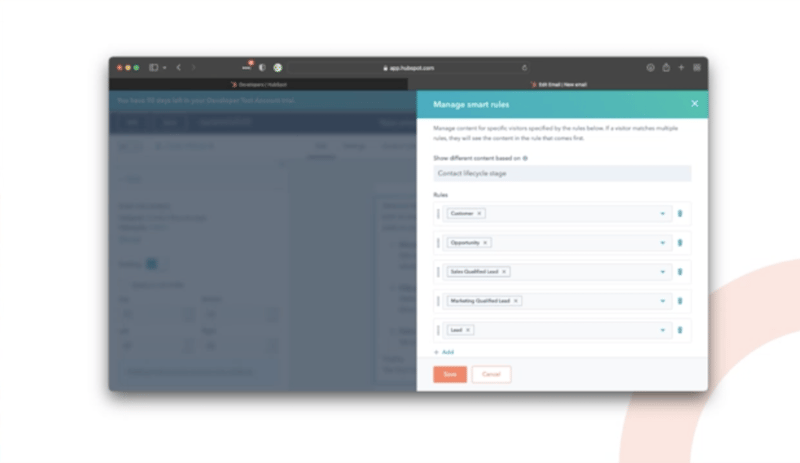
You’ll always need a general default version in case they don’t match any of the buckets in the smart rules you set up. Think about what you want to check for first, I’ll set customer as a first priority to check for and then go in order of importance.
Once you select the smart rule, you can click through the different variations and change as needed.
You can even change the entire content of an email itself. You can send a customer a completely different email than someone who is a lead, all in one email.
It provides a ton of flexibility which is key to leveraging smart content.
Bringing Personalization to Life
So how does this come to life on your contact side? Let's go through some examples.
Customer Onboarding Example
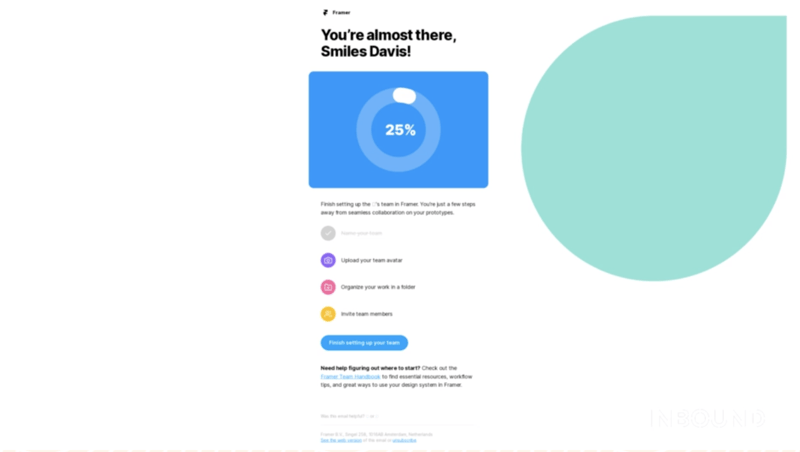
In this instance, you have a new customer and want to make sure they check off all the tasks they need to complete to get the most out of your service.
You can keep your headline static but add smart content to the image.
You would build a list and see everyone who has become an active customer but they have not done (insert the list of things you want to include on this version of the email).
Smart modules allow you to build this advanced email very easily.
The next steps could be adding a new smart rule based around a different list for everyone who has finished 50% of their onboarding. And of course, include a CTA that drops them back into the platform where they can complete their onboarding tasks.
It’s much more personal and shows the customer exactly where they are in the process. This increases the rate of completion since they can see exactly what they need to do.
Product Recommendation Example
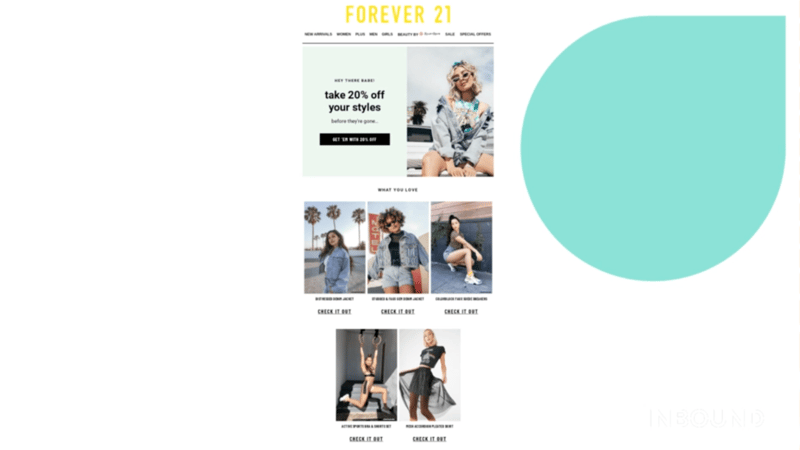
This is based around product recommendations. The 20% offer is probably static, but when you get to the “what you would love” section, this is where smart content is involved. They based this off of page views on the website.
For example, if I know they looked at denim jackets, activewear, etc, then I'll set smart rules to show them related recommendations.
Build a list of who viewed pages of women’s jackets and make a smart rule around that.
Or build a list of who viewed women’s sneakers, then make a smart rule of showing pictures of women’s sneakers in the “what you would love”.
This applies outside of eCommerce. This could just as easily be applied to content. For example, "hey if you liked this blog, then you would like these other blogs or white paper." You could set a property that tags based off of interests as well to target.
Product Usage Celebration Example
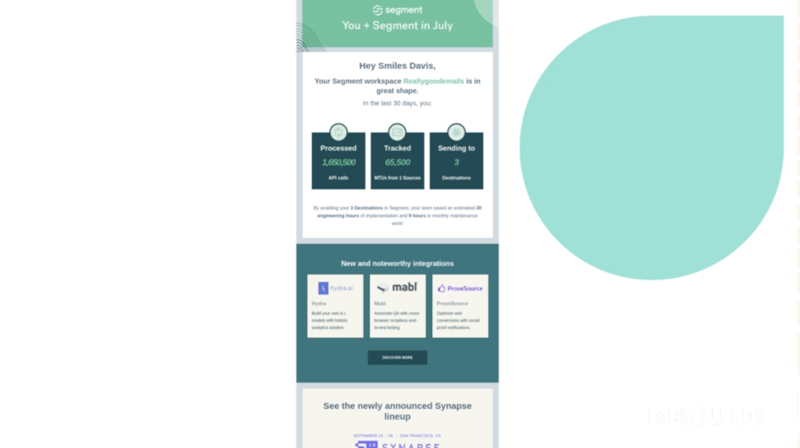
Another example is centered around product usage. In SaaS, you’ll see it’s common to celebrate their usage of the product.
You can easily set up a property that for example, tracks the amount of API calls. Then, you can curate a module based off how many API calls they’ve used.
It’s as easy as taking each of these text modules, setting up lists, and creating smart rules to make sure it’s showing the right information for them.
Come renewal time, it’s incredibly important in SaaS for clients to know the value they’re getting out of your product. Same with a free trial and once they are reaching a certain limit or end of the trial.
Let’s say you’re a subscription box company, you can use this model to celebrate how many subscription boxes they’ve received.
Q&A Session
1. What are the best practices for using smart content and AB testing marketing emails?
When you’re doing AB testing with smart content, it gets difficult. I would not recommend combining the two because you want to have a static version vs. another static version. Do AB testing first to see what resonates and once you have a winner, then optimize it with smart content after.
Get a winner and then put it on steroids with smart content.
2. What are the best ways to use Smart Content for new customer onboarding?
Smart content lets you celebrate each customer and prompts them to take the steps they still need to take so they can get all the value out of your product.
For eCommerce, if you want them to create an account or share some preferences, you can go through a similar flow. Show them what they’ve done already for a sense of accomplishment and the tasks remaining so they know what they still have to go. Keep it really boiled down to the most valuable points to you so there’s not 15 items they have to complete.
3. How will new privacy laws affect it?
HubSpot is going to keep up in terms of functionality and what it means in terms of server-side cookies. We’ll keep up and make sure you can still function off of smart content and get what you need out of it regardless of changes.
If you’re unable to read their information based off of privacy reasons, then they will receive your default version. Make sure to really leverage personalization tokens on the default version to make it as specific to your contact as possible even if they will be receiving the default version.
4. Can you hit a point with smart content when you can go too far?
Yes, it’s a possibility. I don’t think you should get too granular, instead focus on what’s most important to your customer and what’s most valuable to you.
You can say “hey I saw you looked at this page…” but that can get a bit creepy and go a little too far. Ask if they hit this landing page, will this be valuable to them or will it raise privacy concerns?
As marketers, we can become a bit blind to what’s the right balance so it’s great to send people in other departments and send them a test email and get their feedback on if they think it’s valuable.
You ultimately want to encourage the right actions and not surface personal information just for the sake of doing it and it not being helpful on the customer's journey.
5. Can you add smart content to a non-HubSpot CMS website?
No, if you’re using a non-HubSpot website you won’t be able to use smart content on it. HubSpot CMS is a really great value, especially if you’re already using the HubSpot ecosystem to create a seamless experience across website, email, landing pages, etc. You can really do a one-two punch.
6. What are the best practices for smart content in a lead nurturing workflow?
Think about your smart content in conjunction with the branching logic you have in your workflow. When you’re building a workflow, you’ll have enrollment criteria and then branching buckets after. See what makes most sense to personalize in your smart content for each branch.
Use big bucketing branching like lifecycle stage in the workflow branching and get more granular with smart content by basing it off of specific lists.
7. Can you see in the email analytics the performance of each smart content variation?
You won’t see a breakout in content variation. When you have smart content in there, you’ll see aggregated clicks across all analytics. You don’t get it broken out by option. You can get around this with specific UTM links per smart content variation.
This would be hyper-valuable and would be great to get on the road map for HubSpot though.
8. Is there a minimum email recipient amount to successfully implement smart content?
I don’t think there’s a minimum. If you’re super low volume and only sending 100 emails a month, you probably just won’t see a huge swing or change in trends but I still recommend getting in and seeing what works and what doesn’t.
9. How do you use smart content if you have clean data issues?
It’s hard. This really goes beyond the platform, but your sales leader needs to be the standard to lead the sales team to update their records when talking to customers and putting in good information.
What’s Next: How to Navigate Marketing Around Search and Social Algorithms
Speakers: Niel Patel, NP Digital CMO
Today we are breaking down how to navigate around the algorithm. People say “Facebook is dead, SEO is dead, or Tik Tok will become the same thing.” I know the algorithms are getting tougher and tougher, but you can still succeed. I’ll break down how.
When I break down some of the ways you can combat algorithm changes and combat future changes, it’s coming from data. We work with people all over the world and we see a lot of data. And our tool Ubersuggest analyzes tons of data to provide insights into the algorithm. This is coming from data, not opinions.
I get emails every day from people saying that the algorithm sucks, "I wish google and Facebook didn’t have algorithms. It ruined my reach!" Here’s the thing - would you really want to be shown every post from every person you are following? No!
You want to see content that is pleasant and is what you want to see. Imagine watching videos and not getting recommended what to watch next. What if I was getting videos on what to expect when giving birth. I won’t benefit from that, I won’t ever know what that would be like. But for my pregnant wife, that’s very relevant.
You honestly like algorithms, they’re not the issue. The issue is a lack of transparency with the algorithms. If there was transparency, it would make life so much easier. Today, we’re going to solve that.
I don’t know every miniscule part of the algorithm, but I do know what is working.
Why is my organic search limited?
Because platforms want to generate more ad revenue. How to navigate this - there’s a formula.
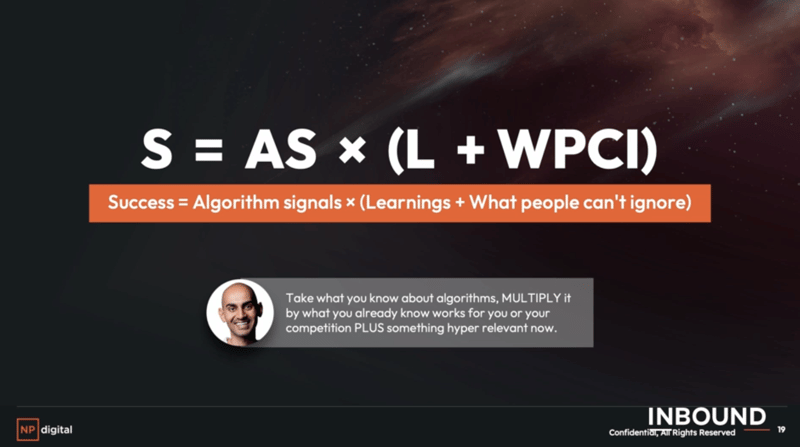
You can find success navigating any algorithm by considering what signals we have (what we do know) and adding in audience learnings and the factors "people can't ignore."
Let's start with signals.
Signals
Algorithm Signals are what the platform is telling you and what we know about the algorithm.
Here's what we know impacts algorithms:
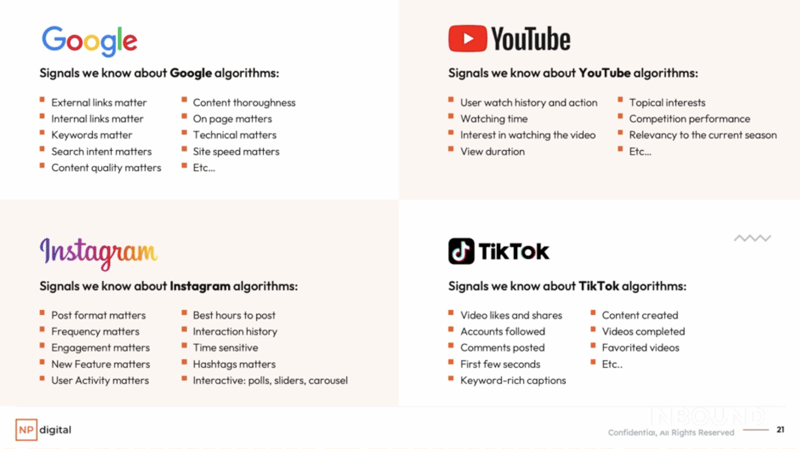
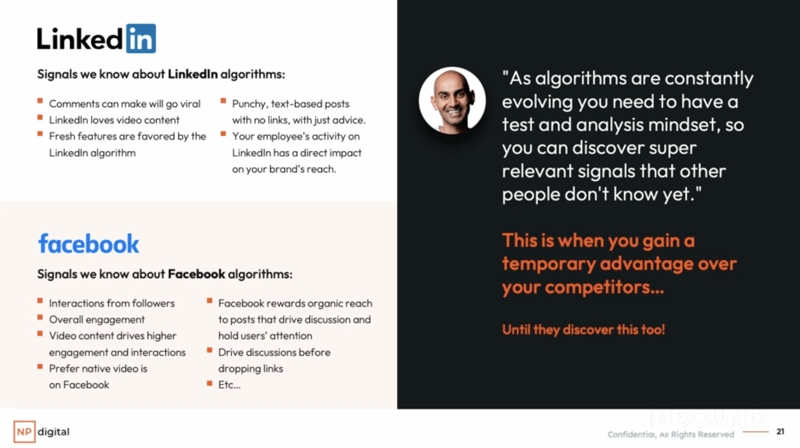
A quick hack on LinkedIn is doing single lines so people will click “read more” on the caption.
All of these you can see and read about online, it’s no secret.
Learnings
The next is Learnings.
This is essentially what you elan from your own audience. Have you seen certain times of the day are the best?
For example, we learn when we create free tools, it works better to gain backlinks than cranking out content.
You can experiment and see if video or carousels resonate better.
What People Can’t Ignore
What people can't ignore is brands.
Build your brand. For example Nike. They are mainly known for shoes but have a ton of different products. Do you know how many people Google the term "shoes" every month? 1.6 million. But over 6 million Googled "Nike" on a monthly basis. Google loves brands because if someone has a brand, they are less likely to create fake news. Same with Facebook. Brands are less risk of sharing misinformation. This isn’t always the case. CNN posted an article about me running for senator. However, obviously, they used the wrong Niel Patel image and used mine as a mistake.
But in most cases, brands don’t crank out fake news (CNN was an honest mistake).
You can harness your brand by participating in events, going live on social, and other brand-building activities.
Strategies per Platform
Let's take a look at some strategies that work per platform.
YouTube
I have one simple hack for YouTube - whatever does really well in the first 24 hours, will get promoted. Follow up a video publishing with a promo strategy to push it out on social media, email blast, etc, within the first 24 hours.
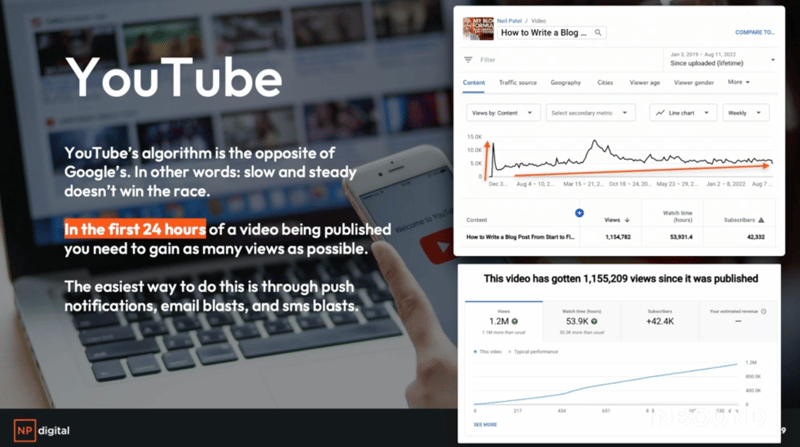
LinkedIn - less than 1% of users create content. They are craving content.
Network with people and try to get them to leave a comment. Comments are very important to getting better results on LinkedIn. This is the secret to LinkedIn - get other people to leave thought-provoking comments on your posts.
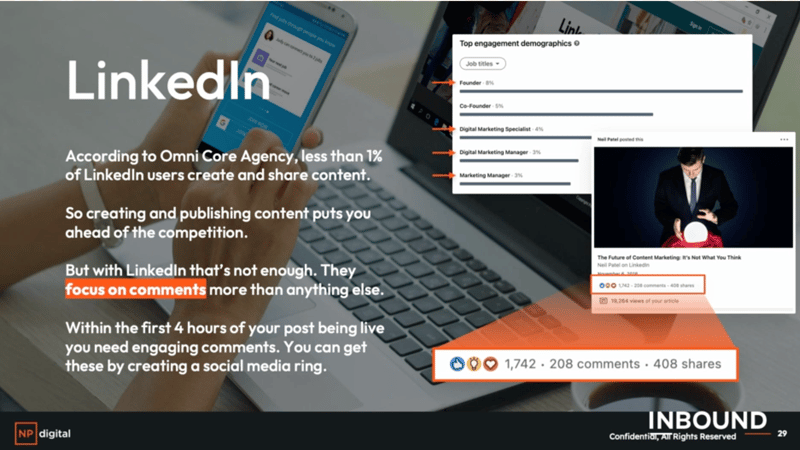
TikTok
TikTok is similar to LinkedIn - it is also all about comments. If you can encourage comments in your video (not just a yes or no comment) then you will go viral.
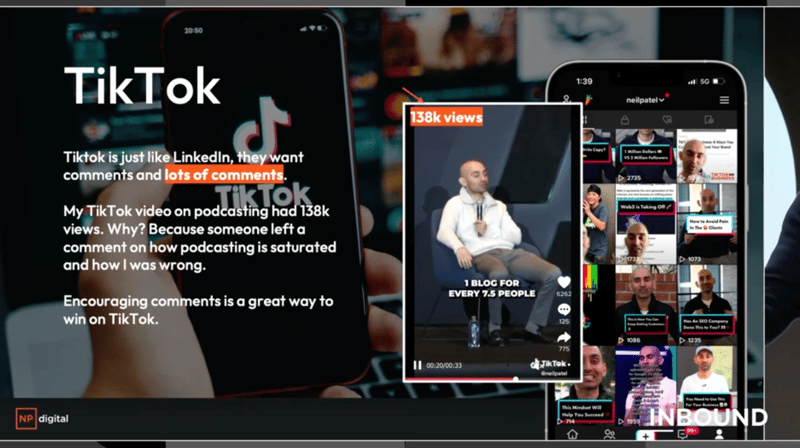
On Facebook, longer-form content does best.
Whatever keeps them on the platform for longer and is be super engaging. Videos longer than 5 minutes perform great.
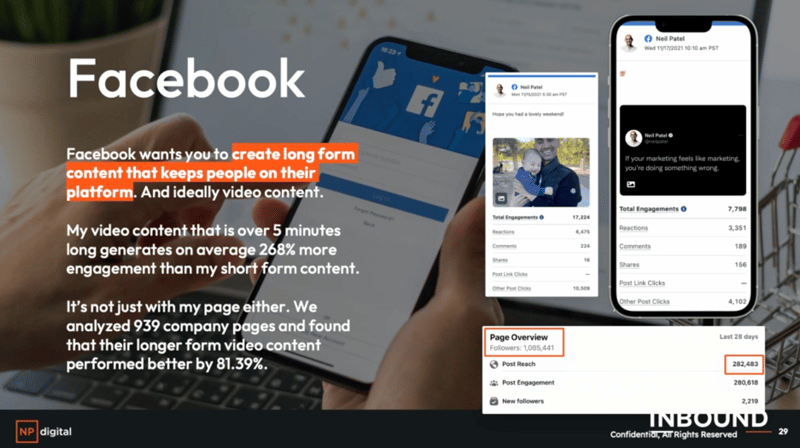
The amount of people on Instagram who do live content has gone down significantly, and Instagram is thirsty for live content.
You’ll get way more engagement on Instagram by doing live content. Go live twice a week with good content (you can repurpose your blogs).
Engage with people and talk to them while you're live.
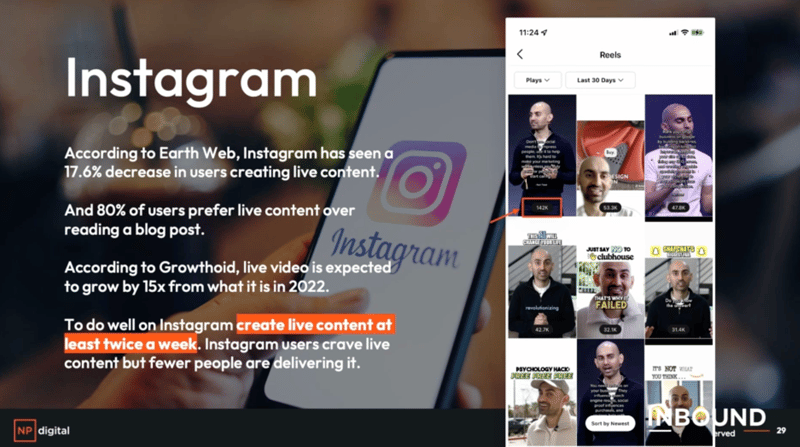
Google is all about brands.
Give stuff away for free. Instead of cranking out content, crank out free tools people can use. You don’t have to spend millions of dollars. There’s a place called CodeCanyon to get free tools and release them as your own for $15-50. These drive more brand queries and clicks than straight content.
To keep growing, you’ll also need to build community.
I do SMS, I do push notifications, really anything to keep building a community.
Some ideas of this are:
- Quizzes. You’ll find a lot of people don’t finish the quiz. But how to use this is to show a quiz on exit intent on the website and you’ll find about 1% will be captured through the quiz.
- SEO analyzer. This lets you generate leads through the help of APIs.
- Content offers. You can collect emails from ebooks. You’ll typically see 20-40% conversion rates. The leads aren’t bad, but they’re low quality. There’s a lot of work to do before they’re ready to buy.
- Consulting
- Free offer or free shipping
- Webinars /virtual summits. Use email blasts, LinkedIn, and ads to promote webinars or virtual summits. They don't convert as high as other sources and you'll have to take a more personalized approach to the specific interest for which they are attending.
- Co-marketing. This is my favorite. It really helps build community. There are a lot of businesses that already have big communities. Promote their services, and they promote your services. Do events together. Find people with related audience sizes as you and then grow together.
- Targeted campaigns. I created a landing page on how to grow YouTube traffic. I collected a lot of emails, and when I released YouTube videos on that topic, I sent them an email about it. Not only does it build a relationship with them but it also helps my videos crush the YouTube algorithm.
What’s Next: What Ryan Reynolds Taught Us About Advertising
Speaker: Ali Haeri, VP, MNTN.
First things first: Ryan Reynolds is MNTN’s Chief Creative Officer and yes, he really works there. He joined the company after his creative agency (Maximum Effort), was acquired. However, his celebrity status is not what makes their advertising successful. To quote MNTN’s VP of Marketing, “Ryan’s knack for storytelling is really, really, good.”
A recent example: MNTN’s dilemma was the need to create a product demo that shows how it works, how easy it is to use, etcetera. The concern was despite Ryan’s charm, having him on camera demoing the product wouldn’t resonate with viewers.
The solution was to invite Steve-O (yes, that Steve-O) to do the product demo instead - but have him eat a Carolina Reaper beforehand (you can watch the ad here).
This is an extreme example, but at the end of the day, there’s no reason B2B marketers can’t have fun with their advertising. Most people wouldn’t jump to featuring a person from Jackass in their ad, but it was a huge hit.
What are the things about storytelling that we’ve learned since working with Ryan?
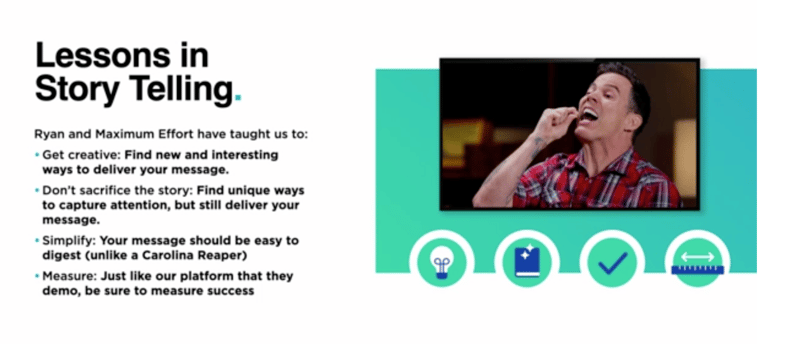
Leveraging Connected TV
A recent study confirms that the priority for B2B marketers is increasing revenue - only one-third are looking to increase brand awareness.
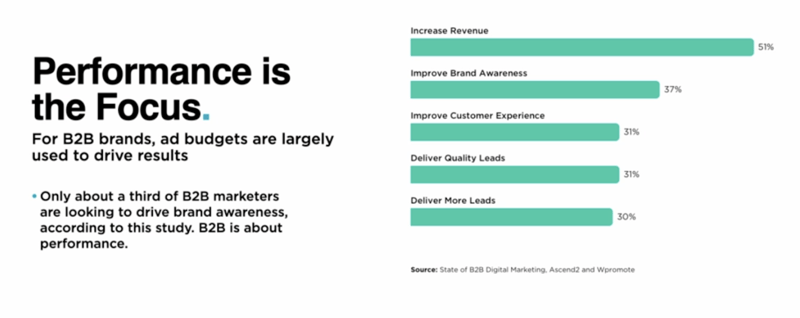
Knowing that, it’s no surprise that B2B marketers rely heavily on performance marketing. A newer tactic with a huge opportunity for growth is Connected TV. Understandably, we haven’t seen a lot of B2B marketing on linear television - it’s shown to a broad audience and can be cost-prohibitive for smaller organizations.
Connected TV is a different approach to television advertising that enables B2B marketers to create targeted audiences and more importantly, track campaign success just like other performance channels
An example: MNTN performed an A/B test with two separate ads: one featured Ryan talking directly to the camera, while the other has him narrating.
The metrics showed that the version that didn’t show his face ended up performing three times better than its counterpart.
Point being - you don’t need a celebrity for success. MNTN has far more success with Ryan’s ability to create a compelling narrative, not the fact that he’s a celebrity (You can see Ryan’s reaction when he learns the one where he wasn’t featured was the clear winner in the follow-up video.)
Three Key Takeaways From This Session:
- B2B businesses can break out of the product demo mold and tell an engaging and compelling story
- Performance marketing far outpaces brand marketing initiatives and Connected TV is an essential tool to help B2B brands achieve these results
- A-list talent isn’t a prerequisite for a successful advertisement
Category Entry Points In A B2B World: Buying Situations To Brand Sales
Speaker: Ty Heath, Director of Market Engagement at The B2B Institute at LinkedIn.
Ads don’t move people in-market. People move themselves in-market once they have been influenced through situational recognition/memories.
The cash flow funnel has a 95/5 rule. It reveals that 95% of buyers are future buyers. Only 5% of your current buyers are in-marketing, the rest are in a growth potential bucket.
How do you take advantage of the 95% who are out-marketing? Branding through memory building.
Category Entry Points
They key to helping you message to this 95% are the following:
- Focus your messaging for memory, not clicks.
- “Category Entry Points are the cues that category buyers use to access their memories when faced with a buying situation” - Profession Jenni Romaniukk
- Situational triggers influence memories being made and remembered. For example: ice cream flavor on a random night, versus ice cream flavor around Christmas. This answer would be drastically different.
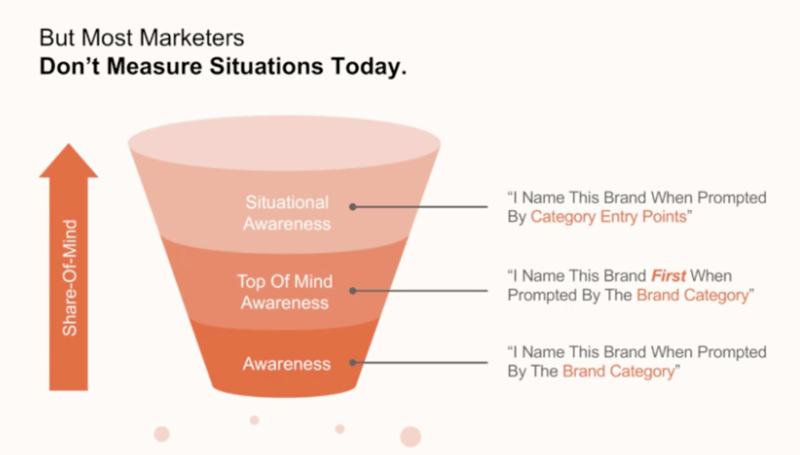
Want to keep learning? Check out the session summary from the next day by clicking the button below.








